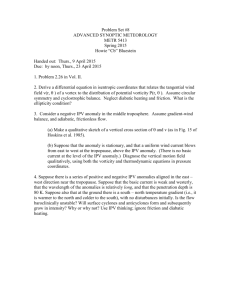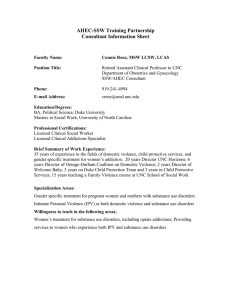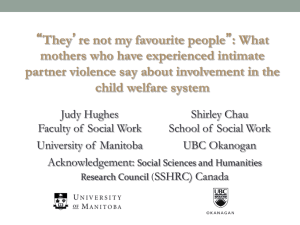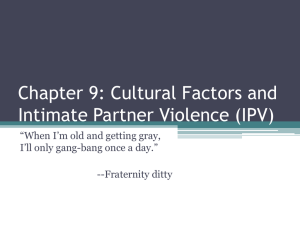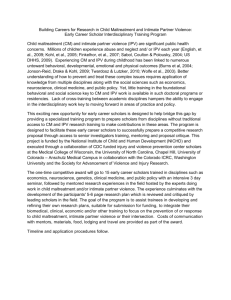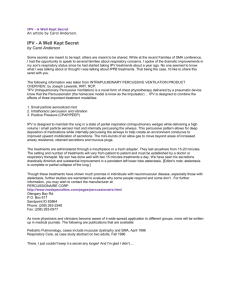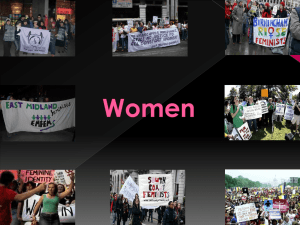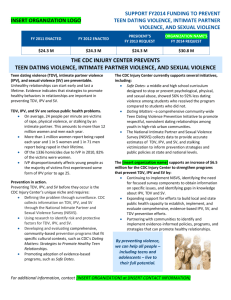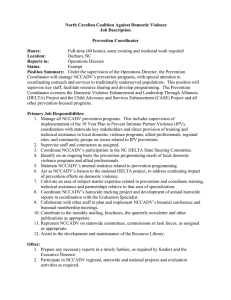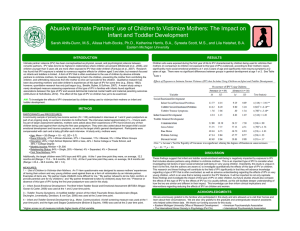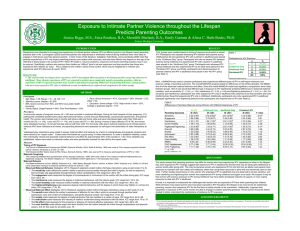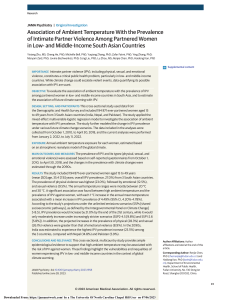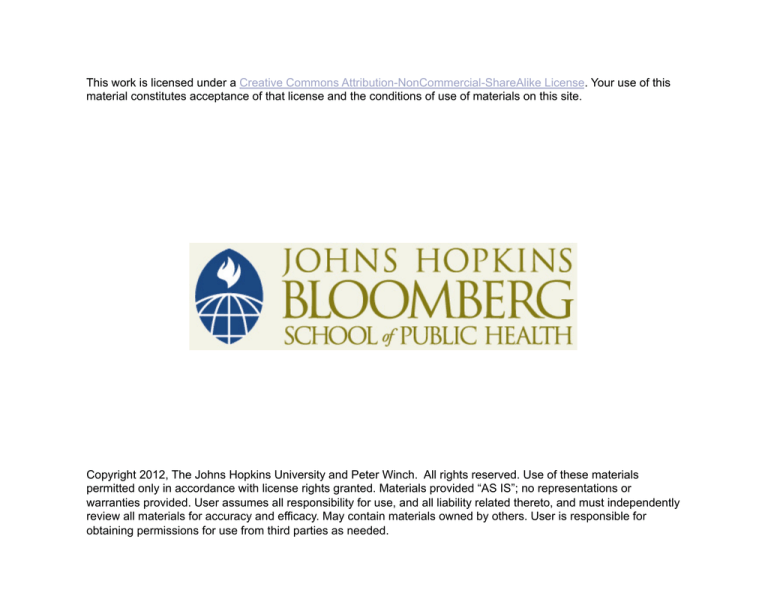
This work is licensed under a Creative Commons Attribution-NonCommercial-ShareAlike License. Your use of this
material constitutes acceptance of that license and the conditions of use of materials on this site.
Copyright 2012, The Johns Hopkins University and Peter Winch. All rights reserved. Use of these materials
permitted only in accordance with license rights granted. Materials provided “AS IS”; no representations or
warranties provided. User assumes all responsibility for use, and all liability related thereto, and must independently
review all materials for accuracy and efficacy. May contain materials owned by others. User is responsible for
obtaining permissions for use from third parties as needed.
Intimate partner violence,
Transtheoretical model
Peter Winch
Health Behavior Change at the Individual,
Household and Community Levels
224.689
Violence
Violence: Three (of many) views
An important public health problem
– Physical injury
– Death
– Psychological effects
A routine punishment in the legal system of
the private domain in many settings
An alternative perspective on behavior
change
Legal/moral systems in the public
and private/domestic domains
Public domain Private domain
Origin of rules
and laws
Monitoring adherence to rules
Punishable
transgressions
Punishment for
transgressions
Rulers, parliaments, courts
Police, civil
servants, courts
Violence, harm
to property
Fines, jail/
prison, capital
punishment,
deportation
Culture/tradition,
household head
Household head,
elders
Disobedience,
sexual transgressions
Withhold money,
food, resources;
expulsion;
violence/IPV
Violence as part of an alternative
perspective on behavior change
Our perspective in
this class
Behavior change
should be voluntary
If people are wellinformed, they can
make their own
choices
Coercion has no part
in behavior change
interventions
Common perspective
in other settings
People need to be told
what to do
People don’t know
what is best for them
“A strong hand” is
beneficial: “He who
spares the rod, hates
his son” (Proverbs
13:24)
Violence as part of an alternative
perspective on behavior change
This is Question 1 for today’s discussion:
– Identify one or two settings from the
experience of the members of the group
where IPV is common
– Discuss what group members have
observed.
– Looking at Figure 3 in Jewkes 2002,
which of the various factors in the
diagram do you think made the greatest
contribution to IPV? Why?
Intimate Partner Violence (IPV)
What is Intimate partner
violence (IPV)?
Violence perpetrated by one intimate partner
(e.g. spouse, boyfriend) against another
Includes
– Psychological aggression (e.g. insult or
swearing at partner or destruction of partner’s
belongings)
– Physical assault (e.g. pushing or shoving
partner or beating up partner)
– Sexual coercion (e.g. using force to make
partner have sex)
Scope of the Problem of IPV
Prevalence rates of IPV are estimated to be 21%
to 55% across studies in clinical care settings and
in general population surveys in the United
States (Jones et al, 1999)
Annual IPV rates range from approximately 10%
to 25% in the United States( Jones et al, 1999; Coker et al, 2000)
Results from international population-based
studies of IPV have found prevalence rates
ranging from 16% to 39%. (Maman et al, 2000; Heise et al,
1995)
Consequences of
Intimate Partner Violence (IPV)
Burke et al. 2004, p 1145
– Serious physical injuries
– Depression
– Other mental and physical sequelae
Maman et al. 2000
– Increased HIV transmission
Factors associated and not
associated with IPV: Jewkes 2002
Associated with IPV
Poverty
Heavy alcohol
consumption
Use of violence is a
social norm
Marital status: Type of
association varies
Number of children
Not associated
Age
Age at marriage
Living in large or
crowded houses
Living with in-laws
Rural/urban residence
How is poverty related to IPV?
Poverty Stress IPV
Poverty Inability to meet expectations of
male role/threats to male identity IPV
Poverty Males have fewer resources or
lower status than females IPV
Poverty Alcoholism IPV
Two key factors (Jewkes 2002)
Unequal position of women
– In relationship
– In society
Normative use of violence in conflict
This diagram was removed because JHSPH
OpenCourseWare could not secure permission
for its use.
For the original diagram, see
Jewkes R. Intimate partner violence. Lancet
2002;359:1423-1429
This chart was removed because JHSPH
OpenCourseWare could not secure permission
for its use.
For the original chart, see
Jewkes R. Intimate partner violence. Lancet
2002;359:1423-1429
South African poster aimed at changing
attitudes: Jewkes 2002, Fig 2.
Prochaska’s Transtheoretical Model
Stages of Change
Originally developed for addictive behaviors
Individual’s readiness to change or attempt to
change toward health behaviors
Basic premise is that people in different points of
the behavior change process can benefit from
different interventions
Stages of Change
Precontemplation stage - an
individual has no interest in changing
because they do not recognize the
behavior as a problem
Contemplation stage - an individual
develops an increased awareness of the
pros and cons of changing.
Preparation stage - an individual
intends to change and has a plan.
Stages of Change cont.
Action stage - an individual is actively
engaged in making changes.
Maintenance stage - the desired
change has been achieved for some
period of time (usually six months) and
the individual is taking steps to prevent
relapse.
Developing interventions using the
Stages of Change
Precontemplation
• increase awareness of need for
change, personalize risk and benefits
Contemplation
• motivate, encourage to make specific
plans
Preparation
• assist in developing concrete action
plans, setting gradual goals
Developing interventions using the
Stages of Change
Action
• assist with feedback, problem solving,
social support, reinforcement
Maintenance
• assist in coping, reminders, finding
alternatives
What stage is she in?
Case One: A pregnant woman is
determined to quit smoking for the benefit
of her unborn child. She is motivated by
her first pregnancy and has determined
that she wants a change in her lifestyle.
She looks in the yellow pages to find “stop
smoking classes”
FROM: Peipert JF and Ruggiero L (1998). Using the transtheoretical model for behavioral change in
women’s health. Women’s Health Issues 8: 304-309
What stage is she in?
Case Two: A pregnant woman who is in her
third pregnancy and has delivered two
healthy children while smoking through
previous pregnancies. She has no desire to
stop smoking and has never considered
giving up tobacco.
FROM: Peipert JF and Ruggiero L (1998). Using the transtheoretical model for behavioral change in
women’s health. Women’s Health Issues 8: 304-309
Stages of Change: Critiques
Too descriptive, does not really get into nuances
of how people move
Too linear
Role of environment limited
Next class
Read this article, will discuss it in class:
– Paul BD, Demarest WJ. Citizen
participation overplanned: the case of a
health project in the Guatemalan
community of San Pedro la Laguna.
Social Science and Medicine 1984;19(3):
185-92.

